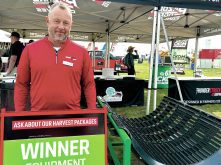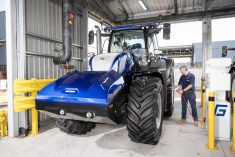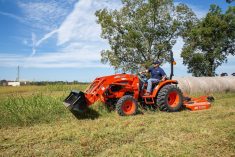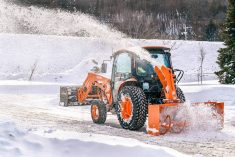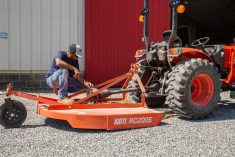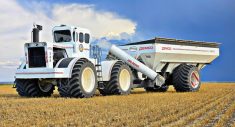Could having autonomous equipment working on your farm improve the operation’s overall profit picture? Agco claims it has demonstrated exactly that during initial field trials of its Outrun retrofit autonomy kit, which it introduced to the farm media near Salina, Kansas in late June.
“What we’re providing is a kit that takes a tractor and allows it to run autonomously, without a driver,” says Agco’s product and marketing manager at PTx Trimble, Dinen Subramaniam. “Our system uses quite a lot of the technology stack that Agco has, everything from guidance, autonomy to computer vision.”
An enclosed system, which bolts onto the roof of a tractor cab, houses most of the electronics. It uses both Doppler and Lidar sensors to “see” its environment. There are also a few electronics mounted inside the cab as well. But the tractor can still me used in the usual way by an operator.
Read Also

Cancer agency reclassifies another herbicide ‘probably carcinogenic’
The WHO’s cancer research agency has now put atrazine, a herbicide well known to corn growers, in the same potential-hazard category where the agency put glyphosate.
READ MORE: Will very-high-horsepower tractors go extinct?
He adds that initial evaluations of the prototype system tested on various farms in the U.S. Midwest showed increased net profit for producers, even on smaller operations.
“It was affordable for the first year on a 900-acre farm, which is a relatively small farm,” he says.” It had a positive ROI [return on investment].”

Those cost savings come from a variety of factors, from reduced labour costs to allowing the tractor to run slower but over longer hours, which reduces engine load during field operations.
“Some of our testing has shown up to seven or eight per cent fuel efficiency savings from going from 100 per cent engine load to 85,” Kevin Jones, senior manager, product management for autonomous operations, adds.

A key feature of Outrun, like all of Agco’s retrofit technologies, is it will be compatible with a range of makes and models. However, its initial market release, expected in 2025, will be limited to 8R John Deere tractors from 2014 and newer, along with as yet unspecified models of Agco’s own Fendt line. The brand expects to expand the range of compatible models in the future.
“Agco is focused on a retrofit first, mixed-fleet approach,” Subramaniam says. “The retrofit approach is taking a tractor a farmer already has, it could be up to a decade-old tractor, they could take your autonomous kit and put it on to enable the tractor to run autonomously.
“We’ve really decoupled the purchase of a new tractor with the enablement of autonomy.”
Outrun’s first commercial application to be released in 2025 will be to pull a grain cart. That system, which allows one combine and one grain cart to work together, is now in the final, beta, development stage. But work is progressing on allowing a pair of carts to service a single combine, which is currently in the earlier alpha development phase. A system of one cart servicing multiple combines isn’t yet in active trials.
“This year… we’re running 10 (single-cart, single-combine) systems,” Subramaniam says. “In alpha this year, we have one combine running with two grain carts.
“This system works without any connectivity needed. It works completely offline. You do need to download some missions. Once you get the field set up. You drive to the field and no longer need any connectivity. Connectivity is still unreliable enough that we just didn’t want to lean on it.”
The combine operator interfaces with the system using a tablet. There’s also some equipment mounted on the combine that enables communication between machines.
But current R&D on Outrun isn’t limited to just grain cart chores. A version that can conduct tillage operations is also under development. It’s in the earlier, first-year, alpha stage.

“In Alpha, the main question we’re trying to answer is, is this the right solution to generate value for the farmer,” Jorge Viramontes, senior manager, product engineering for PTx Trimble, says. “Our goal is to have a select number of units in the hands of farmers for the fall season.”
“One of the first things we did was we went out to farmers and just observed them through the whole crop cycle,” Jones says. “We documented every job they do. We took that back for analysis. When it comes to autonomous tillage we looked at what we have to automate to get that person out of the cab. There were 26 high-level jobs we had to create automations for.”
The tillage system requires an operator to make a manual first pass around the field to set the boundaries and determine if there are any new obstructions in the field the tractor needs to avoid.
A key feature of Outrun is the tillage and grain cart operations don’t require entirely separate systems. Agco’s goal is to have Outrun be capable of handling an entire range of field jobs.
“One of the things I want to highlight is we’re not building different systems for each application,” Viramontes says.
For tillage work, the system’s automation will include bolt-on controls for the implements as well. Those, too, will be designed to work across different brands.
The eventual plan is for Outrun to handle an entire cropping season’s work.
“Agco’s plan is to eventually automate all field operations and have its system compatible with most of the makes and models on market,” Jones says.
“We don’t want to require the farmer to buy a new tractor or new implement. We want to take the technology and insert it onto his current fleet. It opens the door to a huge segment of the industry we can take this technology to now.”
When Agco begins selling the system there will be a one-time initial purchase cost for the system, its installation and operator training. After that, producers will pay for actual hours of use through a subscription. And owners can chose to buy a block of hours or operate on a pay-as-you-go basis. Only hours where the tractor is actually working autonomously will be billed.
“When we look at the entire crop cycle, we think autonomy will add value to that,” Subramaniam says.




